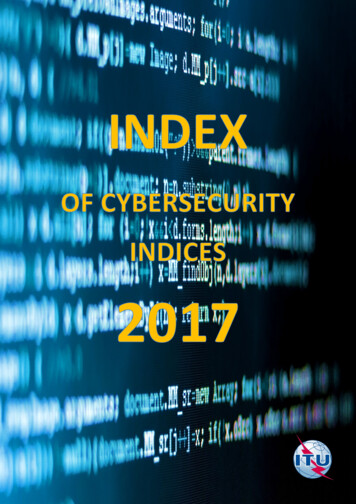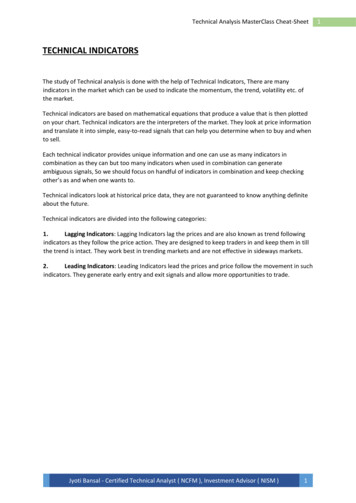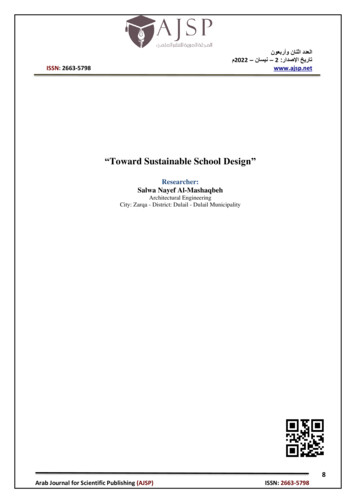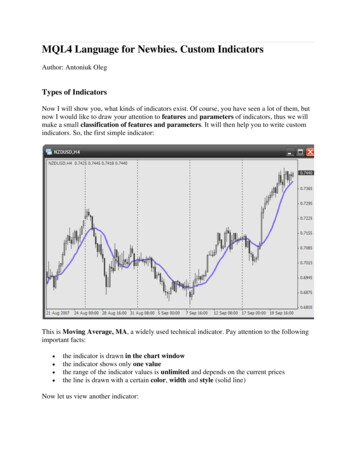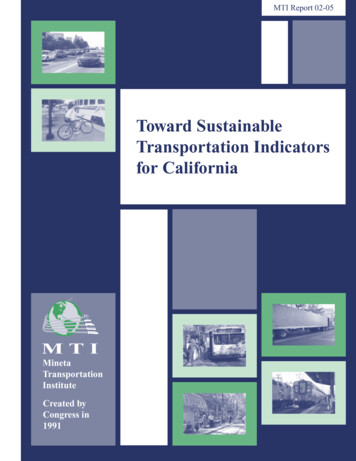
Transcription
MTI Report 02-05Toward SustainableTransportation Indicatorsfor CaliforniaMinetaTransportationInstituteCreated byCongress in1991
MINETA TRANSPORTATION INSTITUTEThe Norman Y. Mineta International Institute for Surface Transportation Policy Studies (MTI) was created byCongress through the Intermodal Surface Transportation Efficiency Act of 1991 (ISTEA) and established in theCalifornia State University system at the San José State University College of Business. MTI continues as aUniversity Transportation Center (UTC), reauthorized in 1998 by the Transportation Equity Act for the 21 Century(TEA-21).stMTI is unique among UTC’s in two areas. It is the only center with an outside, internationally respected Board ofTrustees, and it is the only center located in a College of Business. The Board provides policy direction, assists withneeds assessment, and connects the Institute and its programs with the international transportation community. TheInstitute’s focus on policy and management resulted from a Board assessment of the industry’s unmet needs andled directly to the choice of the San José State University College of Business as the Institute’s home. MTI appliesthe focus on international surface transportation policy and management issues in three primary areas:ResearchThe Institute aims to provide policy-oriented research for all levels of government and the private sector, to fosterthe development of optimum surface transportation systems. Research areas include: security of transportationsystems; planning and policy development; interrelationships among transportation, land use, the environment, andthe economy; financing of transportation improvements; and collaborative labor-management relations. CertifiedResearch Associates conduct the research. Certification requires an advanced degree, generally a Ph.D., a recordof academic publications, and professional references. Research projects culminate in publication available bothin hardcopy and on the Institute’s website.EducationThe educational goal of the Institute is to provide graduate-level education to students seeking a career in thedevelopment and operation of surface transportation programs. MTI, through the College of Business at SanJosé State University, offers an AACSB accredited California State University Master of Science in TransportationManagement and a Graduate Certificate in Transportation Management that will prepare the nation’s transportationmanagers for the 21st century. The masters degree is the highest conferred by the California State Universitysystem. With the active assistance of the California Department of Transportation, MTI delivers its classes overa state-of-the-art broadcast videoconferencing network throughout the State of California and via webcastingbeyond, allowing working transportation professionals to pursue an advanced degree regardless of their location.To meet the needs of employers seeking a diverse workforce, MTI’s education program promotes enrollment tounder-represented groups.Information and Technology TransferMTI’s third responsibility is to develop and maintain electronic information systems to store, retrieve, anddisseminate information relating to surface transportation policy studies. The Institute’s website, TransWeb,enables transportation professionals, students and individuals worldwide to access information relating to surfacetransportation research and policy. TransWeb is found at http://transweb.sjsu.edu and delivers regional, state,national, and international transportation information. The Institute also maintains a library of periodicals andother unique publications for transportation research in cooperation with the San José State University Librarysystem. MTI is funded by Congress through the United States Department of Transportation Research andSpecial Programs Administration (RSPA), the California Legislature through the Department of Transportation(Caltrans), and by private grants and donations.DISCLAIMERThe contents of this report reflect the views of the authors, who are responsible for the facts and accuracy of the information presented herein. This documentis disseminated under the sponsorship of the U.S. Department of Transportation, University Transportation Centers Program and the California Departmentof Transportation, in the interest of information exchange. This report does not necessarily reflect the official views or policies of the U.S. Government,State of California, or the Mineta Transportation Institute, who assume no liability for the contents or use thereof. This report does not constitute a standardspecification, design standard, or regulation.
MTI REPORT 02-05TowardSustainable Transportation Indicatorsfor CaliforniaAugust 2003Richard W. Lee, PhD, AICPPaul Wack, MPA, AICPEugene Jud, FITEwithTapan MunroeJohn AnguianoTrevor Keitha publication of theMineta Transportation InstituteCollege of BusinessSan José State UniversitySan Jose, CA 95192-0219Created by Congress in 1991
Technical Report Documentation Page1. Report No.2. Government Accession No.3. Recipient’s Catalog No.FHWA/CA/OR2002/305. Report Date4. Title and SubtitleAugust 2003Toward Sustainable Transportation Indicators for California7. Authors8. Performing Organization Report No.MTI 02-05Richard W. Lee, Paul Wack, Eugene Jud10. Work Unit No.9. Performing Organization Name and AddressMineta Transportation InstituteCollege of BusinessSan José State UniversitySan Jose, CA 95192-021911. Contract or Grant No.13. Type of Report and Period Covered12. Sponsoring Agency Name and AddressCalifornia Department of TransportationSacramento, CA 958196. Performing Organization CodeU.S. Department of TransportationFinal ReportResearch and Special Programs Administration14. Sponsoring Agency Code400 7th Street, SWWashington, DC 20590-000115. Supplementary Notes.16. AbstractIndicators are an increasingly popular way to present information about a community, region, or agency. As istrue for most statistical measures, indicators are descriptive by their nature. This report focuses primarily onsustainable transportation indicators (STI).Despite the proliferation of indicators–and the proliferation of interest in indicators–there have been only veryfew and scattered attempts to develop comprehensive sustainability indicators for transportation systems. Nonehave been built from the measures and indicators already collected by local and regional transportation agenciesin California. This research addresses that gap, devising and testing sustainable transportation indicators thatmay be effective and practicable in California. In so doing, it builds on both recent research and practice in theU.S., Canada, and Europe. In addition to an extensive review of the literature, a two-stage survey oftransportation professionals and several case studies (three in California plus one of Switzerland) are used toassess the current status of sustainable transportation indicators.The key conclusion is that while there is substantial interest in STI, and much data relevant to STI is beingcollected, more time and more collaboration between transportation agencies and citizen groups are neededbefore STIs will be embedded in the decision-making process of local transportation agencies.17. Key Wordsautomobile usage; plan implementation; transit authorities; transportationpolicy; urban planning19. Security Classif. (of this report)UnclassifiedForm DOT F 1700.7 (8-72)18. Distribution StatementNo restrictions. This document is available to the publicthrough the National Technical Information Service,Springfield, VA 2216120. Security Classif. (of this page)Unclassified21. No. of Pages18822. Price 15.00
Copyright 2003 byMineta Transportation InstituteAll rights reservedLibrary of Congress Catalog Card Number: 2003106356To order this publication, please contact the following:Mineta Transportation InstituteCollege of BusinessSan José State UniversitySan Jose, CA. 95192-0219Tel (408) 924-7560Fax (408) 924-7565E-mail: mti@mti.sjsu.eduhttp://transweb.sjsu.edu
ACKNOWLEDGEMENTSWe would like to thank the many persons and organizations that greatly assisted in the preparationof this report. The Mineta Transportation Institute Project Team consisted of Dr. Richard W. Lee,Principal Investigator, Mr. Paul Wack, and Mr. Eugene Jud; all are MTI Research Associates andfaculty members at the California Polytechnic State University, San Luis Obispo. Dr. TapanMunroe and Mr. John Anguiano of Munroe Consulting contributed heavily to the section TheDevelopment of Indicators of Sustainability.Four highly capable student assistants contributed to the project: Susan Law and Julie Buffaassisted with the literature review, and Ms. Law managed the development and distribution of thesurvey instrument. Kris Szlawkowski provided assistance in the analysis of survey results. TrevorKeith helped on all aspects of the project, and provided critical assistance in compiling the finaldraft report.Special appreciation is also due the following individuals and groups: The more than 2,000 transportation professionals who responded to the initial survey, and themore than 80 who completed a lengthy web-based survey The Institute of Transportation Engineers and Austin O’Dell of the City of San Luis Obispofor the initial survey mailing list Gayle Nakano and others in the Sponsored Programs office at Cal Poly Richard Gilbert, of the CST/CTD in Canada, for early drafts of his Center’s importantinvestigation into sustainable transportation performance indicators All of our faculty colleagues at Cal Poly for their ideas and inspiration All who agreed to be interviewed, provided documents, or assisted the case studies in other ways Karen Austin Keith, who provided editorial and formatting assistance for the draft report Mary Kuehn who provided support and assistance in countless waysWe would also like to thank the staff of the Mineta Transportation Institute for making this projectpossible: Rod Diridon, Executive Director; Trixie Johnson, Research Director; Leslee Hamilton,Communications Director; Sonya Cardenas, Publications Assistant; James Swofford, Editor; andthe graphics/production staff who helped prepare the final report for press: Tseggai Debretsion,Emily Kruger, and Shun Nelson.; and for electronic publication: Barney Murray and Tin Yeung,with administrative support by Young Han, Yesenia Pina, and Amy Yan.
Table of ContentsiTABLE OF CONTENTSEXECUTIVE SUMMARY .1DEFINITIONS.1STUDY PURPOSE, METHOD AND RESULTS .2OVERVIEW, SUSTAINABILITY AND TRANSPORTATION .7BACKGROUND .7THE FUNDAMENTAL ISSUE ADDRESSED IN THIS RESEARCH .9Sustainability and Transportation .9(Newman and Kenworthy, Spaethling, Litman)CONCLUSION: SUSTAINABLE TRANSPORTATION DEFINED .14THE DEVELOPMENT OF INDICATORS OF SUSTAINABILITY .17WHAT ARE INDICATORS? .17Why Use Indicators? .18Criteria for Indicators: What Makes a Good Indicator? .18WHAT IS THE HISTORY OF INDICATORS? .21Introduction .21Bruntland Sustainability and Agenda 21 .22U.S. Efforts .22California .23Sustainable Seattle .24The International Sustainability Indicators Network .25Conclusions .26TWO RECENT SUSTAINABLE TRANSPORTATIONINDICATOR PROJECTS .27Sustainable Transportation: Conceptualization andPerformance Measures .27The CST STPI Project .27DEFINING SUSTAINABLE TRANSPORTATION INDICATORS .33EXAMPLES OF STI–FOR USE BY LOCAL ANDREGIONAL AGENCIES .36Roads and Highways .36Public Transit .38Commute Indicators .40Alternative Transportation .42Cost of Transportation .43Mineta Transportation Institute
Table of ContentsiiEnvironmental Impacts .44Safety and Security .46Air Travel .47SURVEY OF TRANSPORTATION PROFESSIONALS .49SURVEY RATIONALE AND METHOD .49SURVEY RESULTS .52DETAILED SUMMARY OF RESPONSES .61CASE STUDIES OF SUSTAINABLE TRANSPORTATIONINDICATORS .83THE CASE FOR CASE STUDIES .83CASE STUDY: CITY OF SANTA MONICA .84Introduction.84Updating the Santa Monica Sustainable City Program .86Interview with Dean Kubani .89Lessons Learned .91CASE STUDY: SAN FRANCISCO BAY AREA .91Introduction .92MTC Documents Addressing Regional Transportation Indicators. 93BART Documents Addressing Transit System Indicators .99City of Oakland Public Works Department .106CASE STUDY: SAN LUIS OBISPO REGION AND CITY .108Introduction .108SLOGOG RTP and other Regional Efforts .108CASE STUDY: SWITZERLAND .121Introduction .121Switzerland: Federal Level .122Switzerland: City Of Zurich .126CONCLUSIONS FROM THE CASE STUDIES .127OBSERVATIONS AND RECOMMENDATIONS .129SUMMING UP .129Other Findings .130SURVEY FINDINGS .131Principles for Prioritizing STIs .132Sustainability Indicators, STI and Curriculum Development .133CONCLUSION .134Mineta Transportation Institute
Table of ContentsiiiAPPENDIX A: REPORT ON PHASE 3 OF THE STPI PROJECT .135APPENDIX B: SURVEY–SUSTAINABLE TRANSPORTATIONINDICATORS .141APPENDIX C: EUROPE COST C8 COMMITTEE .149APPENDIX D: SWISS NATIONAL RESEARCHPROGRAMME 41, PROJECT C .151APPENDIX E: NEWEST INDICATOR LIST FOR COMMUNALAND CANTONAL ROAD PLANNING AND PROJECTS .153APPENDIX F: MONET PROJECT, AUGUST 2002 .155APPENDIX G: CITY OF ZURICHSUSTAINABILITY CONFORMITY TEST .159END NOTES .161ABBREVIATIONS AND ACRONYMS .163ANNOTATED BIBLIOGRAPHY .165ABOUT THE AUTHORS .185PEER REVIEW .187Mineta Transportation Institute
ivTable of ContentsMineta Transportation Institute
List of TablesvLIST OF TABLESTable 1-1: List of Possible Sustainable Indicators .2Table 2-1: Conventional vs. Sustainable Transportation Planning .13Table 2-2: Transportation Sustainability Principles .15Table 2-3: Characteristics of Effective Transportation Policy .15Table 3-1: Initial Long List of STPI Compiled by CST .30Table 4-1: Agencies and Consultants Responding to theSustainable Transportation Indicators Survey .51Table 4-2: List of Possible Sustainable TransportationPerformance Indicators for Survey .53Table 5-1: Santa Monica Sustainable City Program Indicators .88Table 5-2: Project Evaluation Guidelines (weighted),City of Oakland Sustainable Development Initiative .107Mineta Transportation Institute
viList of TablesMineta Transportation Institute
List of FiguresviiLIST OF FIGURESFigure 3-1: The Relationship of Transportation to Ecology,Economy, and Society .35Figure 3-2: Some Important Considerations for MeasuringTransportation Systems .35Figure 3-3: Key Areas of Sustainable Transportation Indicators .36Figure 3-4: Example Chart From Extra Vehicle Operating Costs.38Figure 3-5: Example Chart, Santa Monica Sustainable City ProgramMunicipal Bus Ridership .39Figure 3-6: Example Chart, Commute Profile 2001: Survey ofSan Francisco Bay Area Commute Patterns .41Figure 3-7: Example Chart, Santa Monica Sustainable City ProgramReduced Emission Fuel Use .42Figure 3-8: Example Chart, Altamont Pass Commuter SurveyCommute Costs.43Figure 3-9: Example Chart, East Bay Indicators 2001, Air Quality.45Figure 3-10: Example Chart, State Farm “Dangerous Intersections” Project .46Figure 3-11: Example Chart, East Bay Indicators 2001, Airport Use .48Figure 4-1: Survey Results–Primary Function of Agency .61Figure 4-2: Survey Results–California-Based Participants .62Figure 4-3: Survey Results–Sustainable Transportation Definition .63Figure 4-4: Survey Results a)–Realizing Economic, Environmentand Equity Goals.64Figure 4-5: Survey Results b)–Financing a Sustainable TransportationSystem.65Figure 4-6: Survey Results c)–Promoting Environmentally FriendlyTransportation.66Figure 4-7: Survey Results d)–Reducing Automobile Use .67Figure 4-8: Survey Results e)–Reducing Per Capita Travel.68Figure 4-9: Survey Results f)–Environmentally SoundTransportation Modes .69Figure 4-10: Survey Results–Importance of SustainableTransportation Indicators. 70Mineta Transportation Institute
List of FiguresviiiFigure 4-11: Survey Results–Transportation Performance Indicators:Standpoint of Surface Transportation Overall .71Figure 4-12: Survey Results–Transportation Performance IndicatorsComparison .71Figure 4-13: Survey Results–Transportation Performance Indicators:Standpoint of Surveyed Individuals’ Transportation Agency 72Figure 4-14: Survey Results–Transportation Performance Indicators:Public Transit Operations .73Figure 4-15: Survey Results–Transportation Performance Indicators:Public Transit Operations (%) .73Figure 4-16: Survey Results–Transportation Performance Indicators:Street and Highway Management .74Figure 4-17: Survey Results–Transportation Performance Indicators:Street and Highway Management (%) .74Figure 4-18: Survey Results–Transportation Performance Indicators:Transportation Consulting .75Figure 4-19: Survey Results–Transportation Performance Indicators:Transportation Consulting (%) .75Figure 4-20: Survey Results–Transportation Performance Indicators:Transportation Planning Agency .76Figure 4-21: Survey Results–Transportation Performance Indicators:Transportation Planning Agency (%) .76Figure 4-22: Survey Results–Transportation Performance Indicators:Other . 77Figure 4-23: Survey Results–Transportation Performance Indicators:Other (%) .77Figure 4-24: Survey Results–Transportation Performance Indicators:California Based Agencies .78Figure 4-25: Survey Results–Transportation Performance Indicators:California Based Agencies (%) .78Figure 5-1: Example, Sustainability Rose Chart:Wabern Road Project .125Figure 5-2: Example, Sustainability Rose Chart: Murten Road Project .125Figure A-1: The 14 Indicators in the Initial Set of STPI .138Mineta Transportation Institute
Executive Summary1EXECUTIVE SUMMARYThe focus of this study is on developing sustainable transportation indicators applicable toCalifornia surface transportation agencies, both planning and operating. This reportpresents the findings of a survey of transportation professionals regarding the relativeimportance of a list of potential indicators of sustainable transportation as well as severalcase studies of agencies involved with indicators of sustainability or sustainabletransportation, to varying degrees. The report also discusses the development and use ofsustainable transportation indicators.DEFINITIONS“Sustainable development” has been defined in various ways. The simplest statement ofthe best-known definition is: meeting the needs of the present without compromising the ability of futuregenerations to meet their own needs, balancing and integrating a prosperous economy,a quality environment, and social equity the “3 E’s” of sustainability.1By “sustainable transportation” we mean a transportation system that:1. allows the basic access needs of individuals to be met safely and in a mannerconsistent with human and ecosystem health, and with equity within and betweengenerations;2. is affordable, operates efficiently, offers choice of transport mode, and supports avibrant economy;3. limits emissions and waste within the planet’s ability to absorb them, minimizesconsumption of non-renewable resources, reuses and recycles its components, andminimizes the use of land and the production of noise.2IndicatorsIndicators are an increasingly popular way to present information about a community orregion. Indicators are a way to summarize valuable data into an easily readable format.Indicators are used to clarify specific issues by presenting key data concisely.Indicators have been an important part of governmental policy for decades. Only recentlyhave indicators of sustainability and other measures of “quality of life” gained increasingattention.Transportation indicators measure the transportation system. Sustainable transportationindicators are those that demonstrate the vital relationship between transportationnetworks and the ecology, economy, and society in which they are located and serve. Thisstudy defines sustainable transportation indicators (STIs) as regularly updated performancemeasures that help transportation planners and managers take into account the full rangeof economic, social, and environmental impacts of their decisions [emphasis added].Mineta Transportation Institute
2Executive SummarySTUDY PURPOSE, METHOD AND RESULTSDespite the proliferation of indicators–and the proliferation of interest in indicators–therehave been only very few and scattered attempts to develop comprehensive sustainabilityindicators for transportation systems, and none that have built up from the measures andindicators already collected by local and regional transportation agencies in California.This research addresses this gap, seeking out and examining critically sustainabletransportation indicators that may be effective and practicable in California. In so doing, itbuilds on both recent research and practice throughout the U.S., Canada and Europe.The literature on “sustainable development,” “sustainable transportation,” and“sustainable transportation indicators” was reviewed as the basis for preparing a surveyregarding an array of candidate sustainable transportation indicators. This survey wasadministered to a selection of transportation planning and program managementprofessionals. In addition, several case studies of agency programs relating to sustainabledevelopment, transportation planning and operations, and the use of indicators wereconducted, including review of their documents and interviews of agency staff andrepresentatives.Survey ResultsA list of 31 promising transportation performance indicators gleaned from the literatureare examined in this report (Table 1-1).A survey was conducted to explore transportation professionals’ perceptions regardingsustainable transportation indicators. The results of the survey provide insights useful indeveloping performance indicators for local and regional transportation agencies. Thesurvey was used to gain insight into how transportation agency directors and other keystaff define sustainable transportation and view the importance of implementingsustainable transportation indicators.Table 1-1 List of Possible Sustainable Transportation Performance Indicators3NumberIndicator (definition)1.Percentage of household expenditures devoted to transportation, including directexpenditures on vehicles and fares and indirect expenditures, such as residentialparking and taxes spent on transportation facilities2.Average amount of resident’s time devoted to non-discretionary travel3.Person miles traveled versus vehicle miles of travel4.Accessibility of non-drivers to employment centers and services5.Per capita land area paved for roads and parking facilities6.Quality of pedestrian and bicycle environment (e.g., the Pedestrian Environmentfactor used in Portland, Oregon’s regional transportation modeling)Mineta Transportation Institute
Executive SummaryTable 1-1 List of Possible Sustainable Transportation Performance Indicators3NumberIndicator (definition)7.Quality of public transit service, including number of service hours, servicefrequency, average speed relative to automobile traffic speeds, safety, comfort(including number of standees during peak periods, number of bus shelters &other waiting facilities), availability of information, & integration with other modes8.Average number of major services (e.g. grocery, library, school, playing fields,etc.) within walking distance of residents, or average walking distance betweenresidences and public services such as schools and retail centers9.Land use densities (residential) and intensities (commercial)10.Land use mix: e.g., proximity of residential, commercial & employment land uses11.Quality of delivery services (e.g., groceries)12.Quality of mobility services for residents with special mobility needs13.Affordability of public transit service by lower income residents (e.g., fares as aportion of lowest quintile income)14.Portion of residents with transit service within one-quarter mile15.Motor vehicle accident fatalities and accidents16.Per capita transportation energy consumption per vehicle mile and passengermile
assess the current status of sustainable transportation indicators. The key conclusion is that while there is substantial interest in STI, and much data relevant to STI is being collected, more time and more collaboration between transportation agencies and citizen groups are needed . investigation into sustainable transportation performance .

